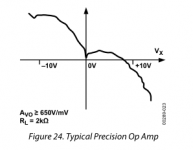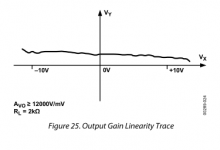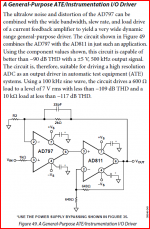My last exposure to 'analogue' sound, at the recent Sydney hifi show, left me rather non-plussed: polite and lethargic are perhaps the best adjectives to use. I have heard better, much better in analogue -- perhaps that crowd have given up ...Well fas42, 'kinky sound' is what I hear in digital as well. You apparently like it.
It is a shame that people can't point to a reference sound, as one can for colour or temperature, say -- it's very hard to convey the qualities of sound, as an object in itself, using words ...
Frank
This is not a useful test. We KNOW that the AD797 measures very, very good, with static distortion. Slew rate should be adequate as well.
If any and everyone of you wants to use an AD797 as a line amp, be my guest.
I personally would use an AD825, myself, and use the AD797's in my test equipment.
20v/us is sufficient ....?
If i made no mistake, the open loop bandwitch of this AD797 is 5500Hz.
The way I read the DS (fig16), the OL gain is already falling at 100Hz 6dB/8ve so the OL BW must be lower than this. They don't show below 100Hz.
It is almost impossible to measure the actual nonlinearity of an AD797 at low levels (typical working levels) because the high negative feedback and the residual noise floor hides it.
John do you mean this kind of low-level? Looks pretty kinky to me - anyone know what happens when we close the loop around such a kinky TF?
(Pic taken from DS of OP177)
Attachments
well you could put a R to a rail to SE Class A bias the output
AD797 has ~500 uA output bias so should supply ~+/-1 mA in push-pull
and that's plenty to drive a real buffer or CFA op amp input of MegOhm||pF if you need more output
you really don't have to only use just one op amp if you really want superior performance
DSL driver CFA op amp for instance are designed, speced to compete on distortion at 100 kHz- few MHz while driving W into 25 Ohm - audio cross over distortion is not a problem
wrap a "good" "audio" input op amp feedback loop around one of the DSL drivers to clean up thermals and what's left to complain about?
AD797 has ~500 uA output bias so should supply ~+/-1 mA in push-pull
and that's plenty to drive a real buffer or CFA op amp input of MegOhm||pF if you need more output
you really don't have to only use just one op amp if you really want superior performance
DSL driver CFA op amp for instance are designed, speced to compete on distortion at 100 kHz- few MHz while driving W into 25 Ohm - audio cross over distortion is not a problem
wrap a "good" "audio" input op amp feedback loop around one of the DSL drivers to clean up thermals and what's left to complain about?
Last edited:
I take it PMI fixed this without resorting to classA biassing the output stage - the schematic still shows the typical complementary pair, the total supply current is 2mA and the plot of the device I've attached. The gain linearity problem would appear to be elsewhere.
Attachments
What IC was that?
They don't say - its only presented (in the DS for OP177) to say 'look how ours is better!' - great marketing
Incidentally John, have you come across this paper before - you might find it interesting? In a nutshell its about how opamp LTP input stages can act rather like balanced mixers...
Attachments
They don't say - its only presented (in the DS for OP177) to say 'look how ours is better!' - great marketing
Incidentally John, have you come across this paper before - you might find it interesting? In a nutshell its about how opamp LTP input stages can act rather like balanced mixers...
Very interesting paper.
The AD797 can't properly drive its own feedback loop. jcx
that's why you hang the feedback from the output buffer/CFA in the composite - its even a datasheet circuit
sub regulate the input op amp's supplies and you can stack the PSRR too
Attachments
Last edited:
I take it PMI fixed this without resorting to classA biassing the output stage - the schematic still shows the typical complementary pair, the total supply current is 2mA and the plot of the device I've attached. The gain linearity problem would appear to be elsewhere.
Well, DUH!! The gain is shown as 12000V/mV while the previous 'bad' one was shown as 650V/mv. A factor of 20 difference. Add to that the fact that they conveniently don't show a Y-scale and they can proof anything this way. Are you engineering types now falling for common marketing tricks?
jan
Is the AD797 the opamp to beat?
Depends on the application. There's no such thing as a universal amplification block. It's got very low voltage noise, not-so-low current noise, as an example.
This thread is rather about political arguing than engineering arguing. Yes, marketing tricks  . We will never see a comparison of Blowtorch FFT distortion measurements vs. AD797 measurements - both measured under same conditions on the same instruments. One of the reason might be that Blowtorch FFT measurements most probably do not exist. If they existed, John would certainly have shown them here. And again, it is impossible to compare measurements made by distortion magnification technique (Grooner) with conventional measurements a la Stereophile.
. We will never see a comparison of Blowtorch FFT distortion measurements vs. AD797 measurements - both measured under same conditions on the same instruments. One of the reason might be that Blowtorch FFT measurements most probably do not exist. If they existed, John would certainly have shown them here. And again, it is impossible to compare measurements made by distortion magnification technique (Grooner) with conventional measurements a la Stereophile.
KINKS:
Your image copied from Grooner publication does not describe the measurement setup - gain and method used. Thus it is useless and misleading.
OK everyone, I don't usually measure op amps for a living, so I have never used the DISTORTION MAGNIFICATION TECHNIQUE. However, just a look at a distortion waveform at ANY LEVEL can give me an idea of the circuits performance.
Would you show such Blowtorch measurements?
well we can gather that he hasnt had to magnify the distortion to get a meaningful measurement, such as with AD797.... or maybe I read too much into the statement that John has never needed a distortion magnification circuit for his measurements?
AD797 has stiff competition in pure noise stakes with lme49990, opa1641, opa1652, perhaps if we include DC accuracy with opa827 and I can never remember the new AD parts that are supposed to be an update on AD797? but its still one of my favorites
AD797 has stiff competition in pure noise stakes with lme49990, opa1641, opa1652, perhaps if we include DC accuracy with opa827 and I can never remember the new AD parts that are supposed to be an update on AD797? but its still one of my favorites
Last edited:
- Status
- Not open for further replies.
- Home
- Member Areas
- The Lounge
- John Curl's Blowtorch preamplifier part II


